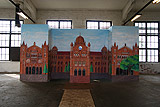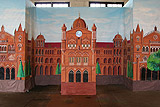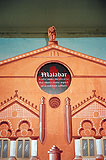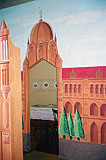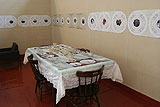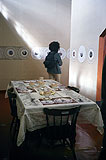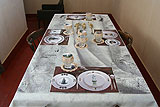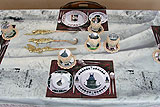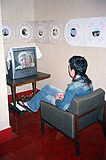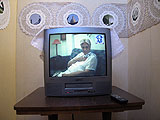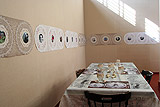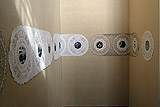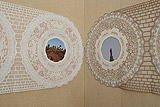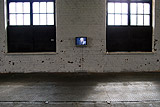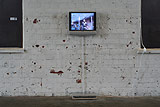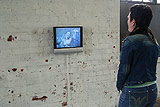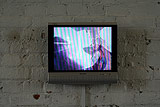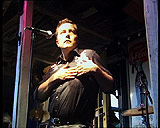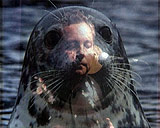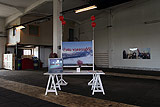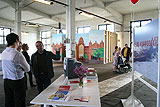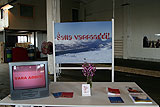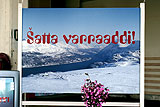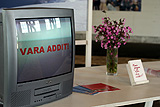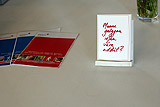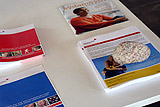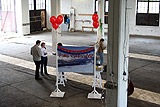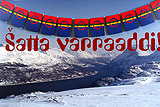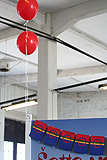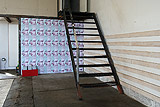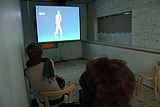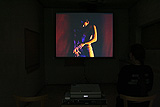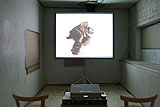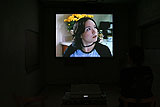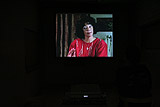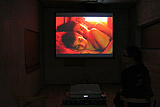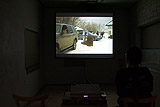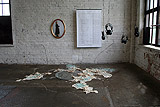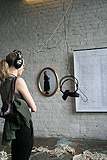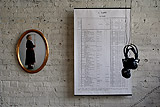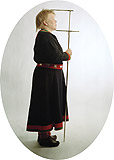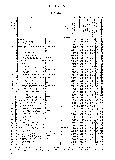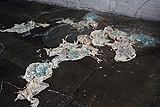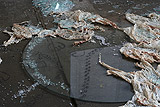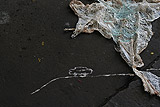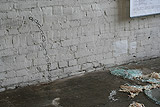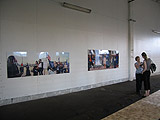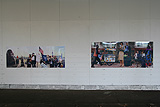
Colonialism Within: Indigenous Rights and Multicultural Realities
VR:n Veturitalli (Finnish Railways Locomotive Engine Shed), Rovaniemi
June 16 – July 9, 2006
A deserted locomotive engine shed in the woodlands of Rovaniemi – the Finnish gateway to the Sámi homeland area, Sápmi – formed the stage for Act 4’s exhibition. This exhibition focused on indigenousness and questions of representation. Placing the region’s indigenous concerns in a global discussion, it pointed to problems such as racism and ethnic exploitation, and showed that they are not remote problems in former times or other continents. Rather, they are a sort of colonialism within, which must be addressed as such.
The exhibition was accompanied by the film program Silver Screen Resistance.
Participating Artists
Archana Hande (India)
Geir Tore Holm (Sámi, Norway)
Kent Monkman (Cree, Canada)
Katarina Pirak Sikku (Sámi, Sweden)
Fatimah Tuggar (Nigeria/USA)
Click polar bear to see video tour of the exhibition (6:20 min.)
Archana Hande is a visual artist, who holds a BFA in print making from Visva Bharati, Santiniketan (1986-91) and a MFA in print making from MS University of Baroda, India (1991-93). In 2000, she was awarded the Charles Wallace India Trust Arts Award, a residency in Glasgow School of Arts. Hande has had many solo shows, among others: Play House (Mumbai, 1998), The Veil-Shop (Bangalore, Mumbai, 1999), The Journal (Bangalore, 2003), and www dot arrange your own marriage dot com (Mumbai, 2005). She has participated in many national and international group shows, among others: Sites of Recurrence (Borås Konstmuseum, Sweden and Dakshinachitra, Madras), The Edge of Desire: Recent Art in India (Art Gallery of Western Australia, Perth; Asia Society and Museum, New York; Tamayo Museum, Mexico City; and Museum of Contemporary Art, Monterrey), Art Circus (Yokohama Triennial 2005, Japan), Icon of the Millennium (Mumbai), Are we like this only? (Delhi), and Gift for India (Delhi and Mumbai). From 2001-05, Hande was a member of Open Circle, an artists’ initiative based in Mumbai, during which time she organized and participated in many public space events, for instance Reclaim our Freedom Week (Mumbai) and India Sabka (Mumbai). In 2004, she participated as an artist and an organizer in the World Social Forum in Mumbai and curated the show A/P Artist Proof for Gallery Chemould in Mumbai. In 2005, Hande was the delegation leader for Seeds of Peace and in 2006, she worked as a stage and costume designer on the play “Orientation” for a London-based theater company. Hande has also written articles for a couple of Indian publications. Online art work: www.arrangeurownmarriage.com. [Archana Hande]
Archana Hande participated in Act 4 with a new installation titled “Victoria House.” Produced specifically for Rethinking Nordic Colonialism, the project examined the influence of British colonial rule in contemporary India. Hande describes the project as follows: “When India gained full independence from the British rule in 1947 to become a republic in 1950, the Government of India declared the country a multiethnic, multilingual, multireligious, and democratic republic. Still, the issue of indigenous and minority rights is a major problem, and India has experienced many riots between primarily Hindus and Muslims, which are linked directly to the border issue and the British ‘divide and rule’ theory. My project focuses on five port cities in India, which served as main gateways to India for the Portuguese, the Spanish, and the British: Madras (now renamed Chennai), Bombay (now renamed Mumbai), Calcutta (now renamed Kolkatta), Mangalore (whose name has remained unchanged although the natives call it Mangaluru), and Bangalore. These cities formed the head quarters, or colonial capitals, for the British during the colonial period and hold lots of hidden history. The project traces elements of colonialism, which are still found within these cities, their populations, and India as such: Colonial English, cricket, spoon and fork, suits and dresses, partitions, colonial architecture and statues, English tea, and names on streets, colonies, companies, parks, and landmarks.” [Archana Hande]
Archana Hande, Installation view of “Victoria House” (2006). Mixed media installation, dimensions variable. Photo: © Eija Mäkivuoti, Anne Skole Overgaard, and Archana Hande. Courtesy of the artist and Gallery Chemould, Mumbai
To view video installed installed in the clock tower of the installation (60 min.), click polar bear
To view video from the interior of the installation (83:52 min.), click polar bear
To view Acknowledgements, click ![]() here.
here.
Geir Tore Holm is educated from the Academy of Fine Art in Trondheim, Norway (1995). He has worked as an independent artist since then. Together with Søssa Jørgensen, he founded the home-based mediation project, Balkong, in 1993. Parallel to his individual practice, he has been curating, writing, and teaching. Holm has also worked with theater, in productions by Totalteatret, Beaivvás Sámi Teáhter, and Ferske Scener (recently presenting “Ashes to Ashes” by Harold Pinter). Holm has been especially interested in social relations and power structures, often related to his Sámi background; first discussing individual (staggering) identity connected to the larger cosmos, later addressing social responsibility and problems with and within ethnic culture. Lately, he has contributed to exhibitions at BildMuseet, Umeå (Same, same but different), Castlefield Gallery, Manchester (From elsewhere), Pikene på broen, Kirkenes (Barents Spektakel and Border Dialogue), and at Ringnes, Skotbu. Holm was responsible for the Sámi Art Festival 2002 in Sør-Varanger and the exhibiton CSV – To Visualise Sápmi at Galleri F15, Moss, 2005. From 2002-04, Holm was Assistant Professor at Bergen National Academy of the Arts and has given lectures widely. From 2003, he has been developing the long-term dialogue project Sørfinnset skole/The Nord Land with Søssa Jørgensen in collaboration with Kamin Lertchaiprasert and Rirkrit Tiravanija from Thailand (see www.artinnordland.no). [Geir Tore Holm]
For Act 4, Geir Tore Holm contributed with two works: “Mun rahkistan – in mun ge,” a music video from 2005 and “Vara addit!,” a promotion stand for blood donation from 2006. Holm describes the two works as follows:
“‘Mun rahkistan – in mun ge’ is a version of Serge Gainsbourg’s ‘Je t’aime – moi non plus’ performed by Geir Tore Holm in Sámi language. This music video produced in 2005 consists of concert recordings from the festival Ringnes 2003 mixed with Northern nature and dancing women. Harsh Arctic nature meets Tropical extravaganza. It is love at many levels: physical, religious, ethnic, scenic...”
To view “Mun rahkistan – in mun ge” (5:19 min.), click polar bear
Geir Tore Holm, Installation view of and stills from “Mun rahkistan – in mun ge” (I love you – me neither) (2005). Video DVD, 4:21 min. Photo: © Eija Mäkivuoti and Geir Tore Holm. Courtesy of the artist
“‘Vara addit!’ means ‘Give blood!’ in Sámi language. Blood seems to be more than a red body fluid. Due to its importance to life, blood is associated with many beliefs. A basic one is the use of blood as a symbol for family relationships; to be ‘related by blood’ is to be related by ancestry or descent. This bears closely to bloodlines, and sayings such as ‘blood is thicker than water’ and ‘bad blood.’ The accepted Christian belief is that Jesus’ blood atoned for the sins of the people: ‘This cup is the new testament in my blood, which is shed for you.’ (Luke 22:20). To be ‘of Sámi blood’ has a positive value, or not, depending on the context this is expressed in. Of course you can be proud of your blood and your ancestors, but on the other hand your pride can be a reason to hostility and conflicts, even wars. Millions have given their blood because of the madness of warfare. The main function of blood is to supply nutrients (oxygen, glucose) and constitutional elements to tissues and to remove waste products (such as carbon dioxide and lactic acid). Blood also enables cells (leukocytes, abnormal tumor cells) and different substances (amino acids, lipids, hormones) to be transported between tissues and organs. At the hospitals, there is a major need for blood and it is necessary to always have a stock in readiness in case of diseases and injuries that arise. Blood cannot be produced artificially. The blood donation service needs your assistance to help others. Many people can’t survive without blood transfusions – they are depending on help from you, fellow beings. Scrutinizing the concept of blood provides an intriguing spectacle to a powerful and multiple part of the human composition (an adult person contains approximately around 5 liters). For Act 4 of Rethinking Nordic Colonialism, I found it interesting to make a stand that can inform about blood and simply serve as a stand for the blood donation service in Rovaniemi, recruiting donators among the exhibition’s visitors, especially addressing potential Sámi blood donators by information material in Sámi language printed for this occasion.” [Geir Tore Holm]
Geir Tore Holm, Installation view of “Vara addit!” (Give Blood!) (2006). Promotion stand for blood donation, dimensions variable. Photo: © Eija Mäkivuoti. Courtesy of the artist
Kent Monkman is an artist of Cree ancestry who works with a variety of mediums, including painting, film/video, performance, and installation. His recent work facilitates dialogue about colonial power relations using sexuality as a forum to negotiate power. He has had solo exhibitions at the Art Gallery of Hamilton and the Indian Art Centre, and has participated in group exhibitions in Canada, USA, United Kingdom, and Mexico, including: “We come in peace…” Histories of the Americas (Musee d’art contemporain de Montreal) and The American West (Compton Verney, Warwickshire, United Kingdom). Monkman has created site specific performances at the McMichael Canadian Art Collection and at Compton Verney, and has also made super 8 versions of these performances that he calls “Colonial Art Space Interventions.” Monkman has won numerous awards from the Toronto Arts Council, the Ontario Arts Council, and the Canada Council. His award winning short film and video works have been screened at various national and international festivals. His work is represented in the collections of the National Gallery of Canada, Museum London, the Woodland Cultural Centre, the Indian Art Centre, The Mackenzie Art Gallery, and the Canada Council Art Bank. [Kent Monkman]
For Act 3, Kent Monkman contributed with three films: “A Nation is Coming” from 1996, “Blood River” from 2000, and “Future Nation” from 2005. He describes the films in the following words:
“‘A Nation is Coming’ draws upon prophecy to reflect on the radical advances in technology and diseases that have affected Aboriginal people in the past and the present. Against images of fire, disease, and the bleakness of modern civilization, a Ghost Dancer is resurrected: a symbol of the ill-fated prophecy that promised the restoration of the vanishing buffalo herds and the old way of life. The dancer (Michael Greyeyes) assumes different forms as he finds his way through memories and visions; some are apocalyptic and full of dread, while others, like the Ojibway prophecy of the Eighth Fire, are more hopeful and suggest a new beginning.”
Kent Monkman, Stills from “A Nation is Coming” (1996). Beta ½” transferred to DVD, color, stereo, 24 min. Written and directed by Kent Monkman. A collaboration with dancer/choreographer Michael Greyeyes. Produced by Urban Nation. Photo: © Eija Mäkivuoti. Courtesy of the artist
To view excerpt of “A Nation is Coming” (4 min.), click polar bear
“Blood River”: “Feeling at odds with her white suburban environment, Rose, a hip Aboriginal law student, can barely tolerate her well-meaning, but clueless adoptive mother, Claire. Through Rose’s vivid hallucinatory nightmares, we see an Aboriginal youth trying to survive on the streets of a big city. As he is pimped, bullied and bashed, Rose experiences his terror and isolation. When she finally stumbles on the secret behind her brother Clayton, it’s hard to bridge the gap between the harsh reality of his life and her sugar-coated existence. Maybe she has been too quick to dismiss what she does have.”
Kent Monkman, Stills from “Blood River” (2000). 16 mm transferred to DVD, color, 23 min. Written and Directed by Kent Monkman. Left image: Jennifer Podemski as Rose. Photo: © Eija Mäkivuoti. Courtesy of the artist
To view excerpt of “Blood River” (3:29 min.), click polar bear
“Future Nation”: “Against the terrifying backdrop of a biological apocalypse, a native teenager, Brian, comes out to his older sister, Faith, and homophobic brother, Charles. Conflict erupts among them as desperate survivors from the city seek refuge on the rez from the horrors of a ‘megapox’ epidemic that is quickly devastating urban populations across North America. Through a perilous journey to the city for food, where they rescue Brian’s ‘friend’ in the process (an outrageous drag queen named Tonya), the hungry and frightened youth reach acceptance by facing down their fears.” [Kent Monkman]
Kent Monkman, Stills from “Future Nation” (2005). Mini-DV transferred to DVD, color, 16:27 min. Written and directed by Kent Monkman. Produced by Big Soul Productions and Urban Nation. Left image: Cliff Cardinal and Joshua Jacobs as Brian and Tonya. Photo: © Eija Mäkivuoti. Courtesy of the artist
To view excerpt of “Future Nation” (3:28 min.), click polar bear
Katarina Pirak Sikku is a visual artist of Sámi heritage, who holds a MFA from the Academy of Fine Arts at Umeå University (2005). Her photography, drawings, installations, and text-based work draw from both immediate family history as well as historical facts that have had an impact on her personal life. Sikku’s approach to traditional representation often makes use of subtle displacements, which upsets the logic that organizes established customs. Mourning and grief are some of the emotions invoked by her work, but also humor and a tremendous amount of generosity. She strives for a combined reflection of the political and social arenas as well as the private and public realms of experience. Sikku’s latest exhibition was at Bildmuseet in Umeå, 2005. [Katarina Pirak Sikku]
Katarina Pirak Sikku participated in Act 4 with a new installation on eugenics and racial biology titled “Dollet” (Grasp). She describes the project as follows: “In the past, Sweden was a pioneering country regarding eugenics and racial biology. A fact, which has had reverberations into present time. Many prominent Swedes cherished the advocates of the race questions. The Swedish State Institute for Racial Biology was established in 1922. It was a climax for its supporters and marked the beginning of years of violation of and offences against the Sámi people in particular. Racial biology turned into segregational politics with a system of institutional racism, sometimes difficult to identify. This is where we are now. Our close relatives were present when the white men entered our bedrooms with their measuring instruments and photography equipment. The domination is no further away than that. Just knowing that I can get facts about my relatives from sources about racial biology hurts. Knowing that my predecessors were stripped naked to be photographed and documented for the future hurts. To visit a museum and see my family heirlooms on display for the public hurts. Yes, they are robbed and dishonored.
When I leaf through the material on racial biology, I am appalled by my emotions. Fascination? I meet the gaze of the portrayed. The eyes of a boy look at me with suspicion. A stripped elderly man looks into the camera with a look of ‘If they want to see the arse of an old Lapp, I have to let them.’ I look at the richness of detail in the costumes. The images are beautiful and seductive, which frightens me. When I touch the material where the naked images are, I feel uncomfortable since many try to hide their naked bodies with a slouched posture. I know my questions will never be answered, but I still want to try to understand. How did it feel for the ones who were exposed? Was it regarded a violation? I also ask myself: Is it a violation now? Can I picture myself in that vulnerable position? Do memories in a map have any legitimate value in a judicial state? How are the memories of my culture accounted for? Am I just a visitor without legal rights, visiting a people also without legal rights, history, or country? To be questioned, am I, or am I not, a Sámi? Do memories have any value at all? I want to construct my own maps to establish my self-evident right to exist on the same grounds as everybody else. The maps consist of memories, tales, and narratives. These maps will never be any good as evidence in a judicial process about who has the right to own the land. Memories leave no obvious or readable traces in nature. But my memories are my memories. Nobody can change that.” [Katarina Pirak Sikku]

To listen to English audio track from the installation (12 min.), click polar bear
Katarina Pirak Sikku, Installation view and details of “Dollet” (Grasp) (2006). Mixed media installation with audio track in Swedish, Finnish, and English, dimensions variable. Photo: © Eija Mäkivuoti and Katarina Pirak Sikku. Courtesy of the artist
Fatimah Tuggar is a multidisciplinary artist, who uses technology as both a medium and a subject in her work to serve as metaphors for power dynamics. She combines, objects, images, and sounds from diverse cultures, geographies, and histories to comment on how media and technology diversely impact local and global realities. Her work has been widely exhibited at international venues in over 18 countries on five continents, including: Museum of Modern Art (New York, USA), Museum Kunst-Palast (Düsseldorf, Germany), Centre Georges Pompidou (Paris, France), 24th Biennial of Graphic Art (Ljubljana, Slovenia), Moscow Biennale (Russia), V Salon CANTV (Jovenes, Venezuela), Istanbul Biennial (Turkey), Gwangju Biennale (South Korea), Bamako Biennale (Mali), and 2nd Johannesburg Biennale (South Africa). Her works have also been the subject of various panels and articles, with the most recent being the Signs Journal of Women in Culture and Society and a feature article in Art Papers. Her body of work has also been integrated as parts of academic curricula, in diverse disciplines and discussions from anthropology to media studies. These institutions include Harvard and Yale Universities, Vassar and Smith Colleges, to name a few. Ms. Tuggar’s art education covers three continents and an even broader range of disciplines, traditions, processes, and materials. She attended the Blackheath School of Art in London, United Kingdom, received a BFA from the Kansas City Art Institute, a MFA from Yale University, and did postgraduate independent studies at the Whitney Museum of American Art, New York. [Fatimah Tuggar]
For Act 4, Fatimah Tuggar contributed with two new projects: two large digital montages titled “Plain Veracity” and “The Nebulous Wait” as well as the web project “Triad Raid” (all 2006). Tuggar describes the works as follows: “Borrowing from the familiar language of advertisement, popular entertainment, and folklore as well as drawing from the experiential, I investigate the cultural and social implications of technology. I use it as a metaphor for the power dynamics of creation, consumption, and commodification. Assemblage, collage, and montage are central to my method. I focus on the internal relationships of the individuals within the work, tempered by the surrounding power structures. This philosophy and practice is equally true with my images, objects, and media experiences. Regardless of expressive form, the internal relationships, which connect the viewer to their own and each other’s humanity, is what holds the energy of the ideas. These works are a direct expression of this practice. They engage the tension between the potential and kinetic energies of human relations.
The digital collages use the paradox inherent in the ‘action of waiting.’ It is a vehicle for slowing our meditation on change and to consider our various conflicts, histories, journeys, and opportunities for being human and becoming humane. My web project, ‘Triad Raid,’ engages the viewer/participant in a potentially loaded power space of making choices, or not choosing. Action or lack of action in this digital environment animates elements to create a dynamic collage. This collage is constructed from: Characters icons and totems, Context landscapes and commodities, and Behaviors actions and interactions between all these elements. This encourages the creation of temporary non-linear narratives, which can be constructed or disrupted based on the choices made by the participant. A key factor is the awareness of choice and the consequences of exercising or choosing not to exercise this potential power. Hopefully, this process invites us to face the use, misuse, and disuse of our human potential. I for one know that I am unquestionably implicated in this dynamic.” [Fatimah Tuggar]
![]()
To visit the “Triad Raid” web project, click the icon.
